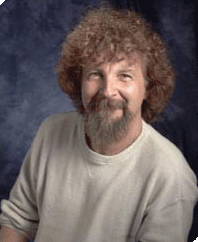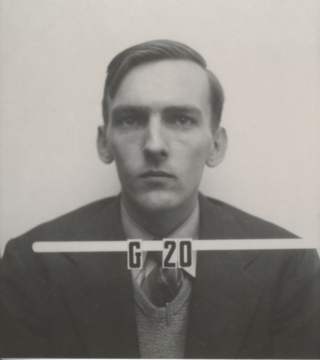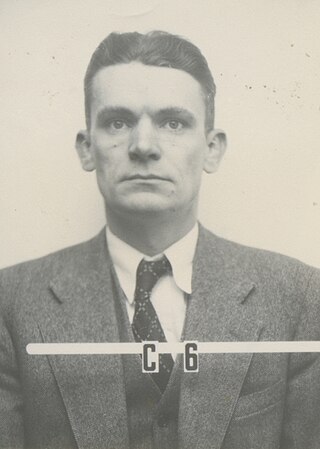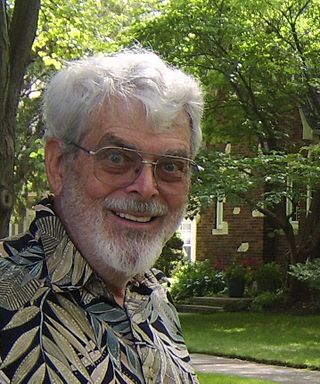
A muon is an elementary particle similar to the electron, with an electric charge of −1 e and a spin of 1/2, but with a much greater mass. It is classified as a lepton. As with other leptons, the muon is not thought to be composed of any simpler particles; that is, it is a fundamental particle.

Val Logsdon Fitch was an American nuclear physicist who, with co-researcher James Cronin, was awarded the 1980 Nobel Prize in Physics for a 1964 experiment using the Alternating Gradient Synchrotron at Brookhaven National Laboratory that proved that certain subatomic reactions do not adhere to fundamental symmetry principles. Specifically, they proved, by examining the decay of K-mesons, that a reaction run in reverse does not retrace the path of the original reaction, which showed that the reactions of subatomic particles are not indifferent to time. Thus the phenomenon of CP violation was discovered. This demolished the faith that physicists had that natural laws were governed by symmetry.

The Santa Fe Institute (SFI) is an independent, nonprofit theoretical research institute located in Santa Fe, New Mexico, United States and dedicated to the multidisciplinary study of the fundamental principles of complex adaptive systems, including physical, computational, biological, and social systems. The institute is ranked 24th among the world's "Top Science and Technology Think Tanks" and 24th among the world's "Best Transdisciplinary Research Think Tanks" according to the 2020 edition of the Global Go To Think Tank Index Reports, published annually by the University of Pennsylvania.

Wojciech Hubert Zurek is a theoretical physicist and a leading authority on quantum theory, especially decoherence and non-equilibrium dynamics of symmetry breaking and resulting defect generation.
The GNU Scientific Library is a software library for numerical computations in applied mathematics and science. The GSL is written in C; wrappers are available for other programming languages. The GSL is part of the GNU Project and is distributed under the GNU General Public License.

In radiography, X-ray microtomography uses X-rays to create cross-sections of a physical object that can be used to recreate a virtual model without destroying the original object. It is similar to tomography and X-ray computed tomography. The prefix micro- is used to indicate that the pixel sizes of the cross-sections are in the micrometre range. These pixel sizes have also resulted in creation of its synonyms high-resolution X-ray tomography, micro-computed tomography, and similar terms. Sometimes the terms high-resolution computed tomography (HRCT) and micro-CT are differentiated, but in other cases the term high-resolution micro-CT is used. Virtually all tomography today is computed tomography.
The eSTAR project was a multi-agent system that aimed to implement a heterogeneous network of robotic telescopes for automated observing, and ground-based follow-up to transient events. The project is a joint collaboration between the Astrophysics Group of the University of Exeter and the Astrophysics Research Institute at Liverpool John Moores University. The project was led by Alasdair Allan and Tim Naylor at the University of Exeter, and Iain Steele at Liverpool John Moores University. The eSTAR Project was affiliated with the RoboNet Consortium, and the global Heterogeneous Telescope Networks Consortium.

Stirling Auchincloss Colgate was an American nuclear physicist at the Los Alamos National Laboratory and a professor emeritus of physics at the New Mexico Institute of Mining and Technology from 1965 to 1974, of which he also served its president.
David Pines was the founding director of the Institute for Complex Adaptive Matter (ICAM) and the International Institute for Complex Adaptive Matter (I2CAM), distinguished professor of physics, University of California, Davis, research professor of physics and professor emeritus of physics and electrical and computer engineering in the Center for Advanced Study, University of Illinois at Urbana–Champaign (UIUC), and a staff member in the office of the Materials, Physics, and Applications Division at the Los Alamos National Laboratory.
VOEvent is a standardized language used to report observations of astronomical events; it was officially adopted in 2006 by the International Virtual Observatory Alliance (IVOA). Though most VOEvent messages currently issued are related to supernovae, gravitational microlensing, and gamma-ray bursts, they are intended to be general enough to describe all types of observations of astronomical events, including gravitational wave events. Messages are written in XML, providing a structured metadata description of both the observations and the inferences derived from those observations. The rapid dissemination of event data with a formalized language was the original impetus for the creation of VOEvents and the network used to transport the messages; indeed VOEvent messages are designed to be compact and quickly transmittable over the internet. The VOEvent language continues to evolve; the latest version is 2.0.

Cargo scanning or non-intrusive inspection (NII) refers to non-destructive methods of inspecting and identifying goods in transportation systems. It is often used for scanning of intermodal freight shipping containers. In the US it is spearheaded by the Department of Homeland Security and its Container Security Initiative (CSI) trying to achieve one hundred percent cargo scanning by 2012 as required by the US Congress and recommended by the 9/11 Commission. In the US the main purpose of scanning is to detect special nuclear materials (SNMs), with the added bonus of detecting other types of suspicious cargo. In other countries the emphasis is on manifest verification, tariff collection and the identification of contraband. In February 2009, approximately 80% of US incoming containers were scanned. To bring that number to 100% researchers are evaluating numerous technologies, described in the following sections.

Peter Brent Littlewood, FRS is a British physicist and Professor of Physics at the University of Chicago. He was the 12th Director of Argonne National Laboratory. He previously headed the Cavendish Laboratory as well as the Theory of Condensed Matter group and the Theoretical Physics Research department at Bell Laboratories. Littlewood serves as the founding chair of the board of trustees of the Faraday Institution.

Matthew Linzee Sands was an American physicist and educator best known as a co-author of the Feynman Lectures on Physics. A graduate of Rice University, Sands served with the Naval Ordnance Laboratory and the Manhattan Project's Los Alamos Laboratory during World War II.
Juan Pablo Paz is an Argentinian physicist that works in the field of quantum computing. A research scientist currently working at the University of Buenos Aires, he has also worked at the Los Alamos National Laboratory in the United States.

Charles Louis Critchfield was an American mathematical physicist. A graduate of George Washington University, where he earned his PhD in physics under the direction of Edward Teller in 1939, he conducted research in ballistics at the Institute for Advanced Study in Princeton and the Ballistic Research Laboratory at the Aberdeen Proving Ground, and received three patents for improved sabot designs.
James P. Crutchfield is an American mathematician and physicist. He received his B.A. summa cum laude in physics and mathematics from the University of California, Santa Cruz, in 1979 and his Ph.D. in physics there in 1983. He is currently a professor of physics at the University of California, Davis, where he is director of the Complexity Sciences Center—a new research and graduate program in complex systems. Prior to this, he was research professor at the Santa Fe Institute for many years, where he ran the Dynamics of Learning Group and SFI's Network Dynamics Program. From 1985 to 1997, he was a research physicist in the physics department at the University of California, Berkeley. He has been a visiting research professor at the Sloan Center for Theoretical Neurobiology, University of California, San Francisco; a postdoctoral fellow of the Miller Institute for Basic Research in Science at UCB; a UCB physics department IBM postdoctoral fellow in condensed matter physics; a distinguished visiting research professor of the Beckman Institute at the University of Illinois, Urbana-Champaign; and a Bernard Osher Fellow at the San Francisco Exploratorium.
Muon tomography or muography is a technique that uses cosmic ray muons to generate two or three-dimensional images of volumes using information contained in the Coulomb scattering of the muons. Since muons are much more deeply penetrating than X-rays, muon tomography can be used to image through much thicker material than x-ray based tomography such as CT scanning. The muon flux at the Earth's surface is such that a single muon passes through an area the size of a human hand per second.

Johndale C. Solem is an American theoretical physicist and Fellow of Los Alamos National Laboratory. Solem has authored or co-authored over 185 technical papers in many different scientific fields. He is known for his work on avoiding comet or asteroid collisions with Earth and on interstellar spacecraft propulsion.
Alice H. Armstrong was an American physicist known as one of the first female scientists at the National Bureau of Standards and as the first woman to earn a Ph.D. in physics from Harvard University, via Radcliffe College. She was elected a Fellow of the American Physical Society in 1931.

Nicole Marie Lloyd-Ronning is an American computational astrophysicist specializing in gamma-ray bursts and the deaths of massive stars as a researcher at the Los Alamos National Laboratory and lecturer at University of New Mexico–Los Alamos. She is also known for her work in science popularization, as the author of the book Great Mysteries in Astrophysics, as a scientist ambassador for the Bradbury Science Museum, and in youth outreach programs, especially for young people from indigenous groups in the American southwest.












